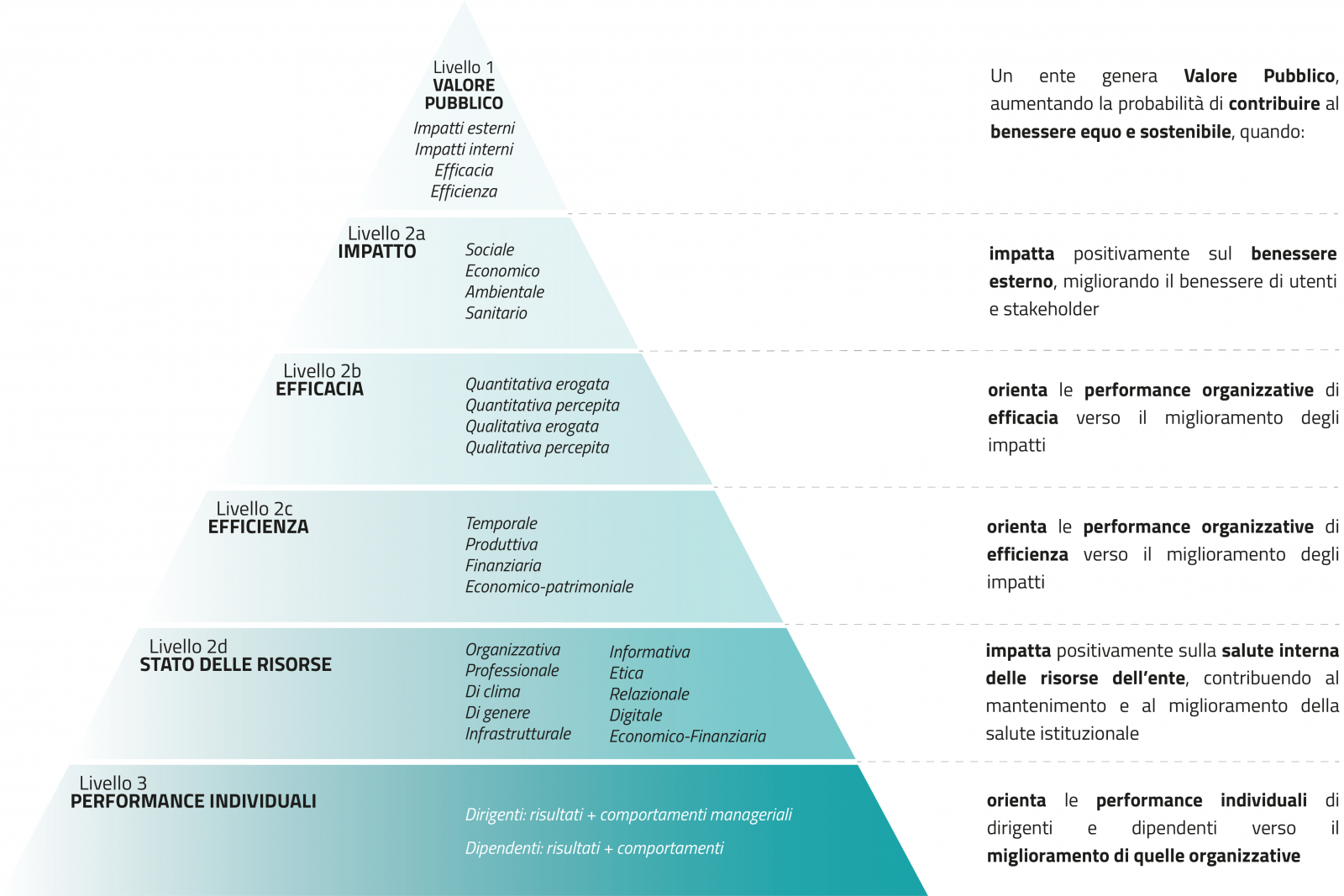Public Value Observatory: the Public Value created by Italian Metropolitan Cities
2021

WHAT IS MEANT BY PUBLIC VALUE?
Creating Public Value, «or rather the improvement in the level of economic-social-environmental wellbeing of the recipients of the policies and public services compared to the starting conditions»[1] in the sense of the ultimate aim of implementing public policies, was introduced thanks to regulatory revisions on matters of performance, beginning with the modifications made in 2017 to Legislative Decree no.50 dated 27 October 2009: the improvement of the performance of Italian public administrations is therefore directed towards creating Public Value, surpassing the traditional compliance and self-referential approach of pursuing the performance expected.
Creating Public Value becomes an institutional imperative in a global scenario characterised by complex problems, consolidating the need to program the PA’s missions, strategies and actions with a view to the common promotion of sustainable policies. This methodological scenario of coordination between the different PAs would make it possible to impact the level of national wellbeing, going beyond the administrative confines of the individual organisations: In a broader vision, it is possible to define the concept of co-creation or shared creation of Public Value, i.e., the creation within interistitutional networks that adopt policies aimed at common objectives.
To achieve this common objective co-producing value over a medium-long term period and ensuring the economic, social and environmental sustainability of the administrative action, the use of a Public Value Governance Model [2] is proposed for managing Public Value, that must innovate and direct Programming, Measurement, Evaluation and Reporting systems of the PAs.
WHAT IS THE OBSERVATORY OF PUBLIC VALUE?
The observatory of Public Value aims to measure the Public Value created by the Public Administrations of the Various sectors (Central Administrations, Local Authorities, Health, Education and Training, etc.) to create moments of dissemination and sharing the results measured with policy makers, users and stakeholders.
The measurement model used is based on the principles of the Public Value Pyramid framework, proposed by Prof. Enrico Deidda Gagliardo. This framework, that uses a pyramid architecture, is divided into various performance dimensions measured using specific indicators. The framework makes it possible to govern the contribution of the performance achieved in the different dimensions (Impact, Effectiveness, Efficiency, Health of the Resources) as well as the flows of value creation in a direction functional to the BES and/or SDGs.

SCOPE OF THE RESEARCH
The scope of the research is to measure the Public Value created for the various sectors and clusters of the PA analysed, by identifying sets of indicators that are based on national and international goals and targets, or rather derived from higher levels of government, but that at the same time can be integrated into the programming instruments of the individual organisations and applied at local level.
Using a common and replicable measurement model, even more so if based on standardisation criteria, can foster the diffusion of shared Public Value programming practices in an interinstitutional logic. It can therefore be presumed that sharing a measurement methodology and its results can encourage constructive comparison between the different entities measured, with the aim of improving the equitable and sustainable wellbeing of the territories.
The most common goals of a public policy aimed at the concepts of wellbeing and sustainability refer to the framework of the SDGs (Sustainable Development Goals) set in the UN’s “2030 Agenda for Sustainable Development” and the beyond-GDP objectives directed towards developing ISTAT’s Equitable and Sustainable Wellbeing (BES).
THE PUBLIC VALUE OF ITALIAN METROPOLITAN CITIES
The first Observatory regards an application concerning the cluster of Italian Local Authorities. In particular, the Public Value created by implementing the policies of 14 Metropolitan cities is measured. The 14 Italian metropolitan Cities are: Turin, Milan, Venice, Genoa, Bologna, Florence, Rome, Bari, Naples, Reggio Calabria, Cagliari, Catania, Messina and Palermo.
The Italian metropolitan cities, present in the Constitution since 2001 and established in Italy by law no. 56 dated 7 April 2014 as “territorial authorities of vast areas”, are the ideal case study, as they were assigned the role of coordination in defining long-term territorial policies by implementing strategic programming on a metropolitan scale.
The metropolitan territories are also a very important series of studies because they extend across more than 15% of the national territory, home to around 36% of the population.
How is it therefore possible to measure the contribution of the Italian Metropolitan Cities in creating Public Value?

Following a selection based on the criteria of reproducibility over time and the availability of data, a set of 88 indicators was collected, divided into the 4 performance dimensions (Impact, Effectiveness, Efficiency and Health of the Resources) and coming from reliable sources [3]. Each indicator was assessed on a scale from 0 to 100, according to the best and worst performance achieved by the 14 Cities, with the possibility of calculating for each of the 14 Cities:
- a partial index for each of the four dimensions
- an overall index of Public Value
RESULTS OF THE RESEARCH
[1] Civil Service Department, Guidelines for the Performance plan – Ministries, No. 1, June 2017.
2] DEIDDA GAGLIARDO E. (2019), Public Value. Or rather, how to direct public performance towards the wellbeing of citizens and sustainable development, starting with the health of the PA, in “National Council for Economics and Labour (CNEL) – 2019 REPORT TO PARLIAMENT AND GOVERNMENT on the levels and quality of services offered by central and local Public administrations to businesses and citizens”, pp. 41-57.
[3] Equitable and Sustainable Wellbeing (BES) of the Territories (ISTAT); Metropolitan Cities compared (ISTAT and Metropolitan City of Bologna); Plan of indicators and expected results (Transparent Administration); MEF annual Report; MEF databases; Metropolitan Cities websites administration; Database of territorial indicators for development policies (ISTAT); ANAC database.
